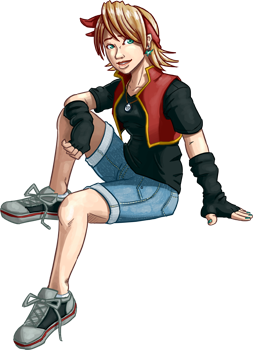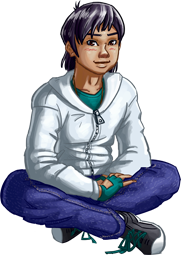I knew from the beginning of development on Another Star how I would apply the theme of “minimalism” to the game’s story, gameplay, and graphics. But what I never was sure on was how to approach the music with minimalism in mind. Just like with the graphics, I didn’t want “minimalism” to just mean “simplistic”.
In the beginning, when the project was meant to be nothing more than a Ludum Dare entry, I decided that, to be minimalist, the game should only have 8 music tracks total. When the game became a full-fledged project I bumped that up to 16 to accommodate the longer story.
But it gets pretty boring to listening to the same few tracks over and over again in a game as long as Another Star. Even thought the game has only 256 tiles for its graphics, they’re combined and used in so many different ways that it stays fairly fresh. I wasn’t sure how to do that with the music, so I kept adding more and more unique tunes. In the first beta alone there were about 30 music tracks total, and a few more will even be added to that for the final tally (at this point I’m considering giving every dungeon its own unique music track).
So my next idea was to apply the “limited tile” concept to music by replacing the NES style chiptunes I was originally using and recreating them using a limited set of low-fidelity instrument samples. It sounded kind of neat, but it didn’t fit the feel of an 8-bit console game. Consoles wouldn’t use PCM instrument samples until much later, with the Super Nintendo’s S-SMP audio chip. (Sure, there was the Amiga’s Paula sound chip which gave birth to the modular music format, but that was a fairly expensive 16/32-bit computer system.) Finally, I just gave up and went with the Japanese Master System inspired YM2413 style that’s going to be in the final game.
It wasn’t until recently that it hit me what I had been doing wrong. The correct way to apply the theme of minimalism wasn’t to limit the number of instruments, channels, or tracks, but to limit the number of themes. I was purposely trying not to reuse leitmotifs in the soundtrack when that was exactly what I should have been doing. I should have come up with a handful of themes (maybe eight or so), and just used them over and over again in new and different ways. The soundtrack of Super Mario World is an excellent example of this. Every single level in the game uses the same music theme, from the sunny plains to the dark castles. But the plains play it fast and upbeat, while the castles play it in a minor key with lots of timpani and staccato strings thrown in.
Alas, by this point most of the music in the game was already done and it’s a little late to throw it all out. Oh well. It’s odd how something I normally gravitate towards but had avoided for so long was the direction I should have gone. I’ll have to be more careful in the future.



I think the whole idea of “minimalism” comes from the problem that (particularly) indie developers often start making a game and then giving up on it / losing interest before ever finishing it. In this sense minimalistic planning is a big help. But I see it more of a “get away from the idea to make THE epic RPG and rather try to design something short and clever” and NOT as something along the lines of “I put a limit X and then I won’t exceed X”.
Especially if you do ENJOY creating music and graphics, there shouldn’t really be something limiting you. You won’t lose interest on a project as long as you enjoy it after all.
Of course it still needs some planning ahead, because if you just make the game without thinking ahead, end up with 300 monsters and then at the 150th monster sprite you suddenly getting tired of drawing monsters then that’s a problem and you probably had been better off making the game shorter so that 150 monster sprites would have been sufficient.
With music I see it quite similar. If you make many dungeons, you want different music for each dungeon or else it will start sound repetitive. If the game is long you might even want to switch the main battle theme every 20 hours or so. But it might end up requiring more different tunes than you actually enjoy doing, ending up with either something very repetitive or another dropped project.
But as you can see, the limit isn’t with how many sounds and graphics you want to do, the limit is with how big you plan the game and if you are able to enjoy developing it from start to end at the planned proportions.
When the 26th Ludum Dare kicked off with the theme “minimalism”, most people chose to interpret it as “use as few simple-looking things as possible”. Although my 256-tile limit sort of fits into that rut, part of my goal was to follow one of the traditional philosophies of minimalism in architecture, which was “find as many uses for one element as possible”. This is why a lot of sprites in Another Star use the same tiles, but arranged in a different way. (For example, the logo on the title screen uses the cave exit sprite’s tiles.)
This idea of reusing leitmotifs and themes in the soundtrack would have been a lot of fun; I usually gravitate towards it when composing anyway. It would have been neat if each dungeon used the same basic melody, but arranged completely differently. A really sad and slow version here, a jazzy upbeat version there, and so on. In fact, knowing me, the game might have ended up with even more music than it has now just because I like reusing musical themes across a soundtrack!